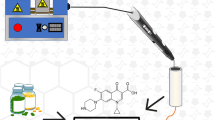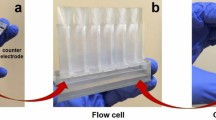Abstract
The design and fabrication of a simple 3D-printed platform with embedded electrochemiluminescence (ECL) detection for sibutramine determination is described. The microfluidic platform was fabricated by the fused deposition 3D-printing technique with polylactic acid filament, facilitated by computer-aided design (CAD). A three-electrode system was integrated into the device using graphene carbon paste as a working electrode, Ag/AgCl wire as a reference, and a graphite rod as a counter electrode. A further modification was carried out by applying bimetallic Au-Pt nanoparticle-supported multi-walled carbon nanotubes (MWCNT-Au-Pt) on the working electrode surface to enhance the electrocatalytic performance by exploiting the unique properties of nanomaterials. The analytical feasibility of the CAD-ECL sensor was tested through its application for the determination of sibutramine in dietary supplements. Under the optimized conditions, based on the enhancing effect of luminol emission, the device exhibited a linear calibration curve of the logarithmic sibutramine concentration versus ECL intensity in the range 5 × 10−3 to 1 ng mL−1. The limit of detection was 3 pg mL−1 with a relative standard deviation of 1.7% (n = 15). The 3D-printed prototype can be successfully applied to a small-scale analysis in a simple and cost-effective approach.
Graphical Abstract









Similar content being viewed by others
Data Availability
Data of this reasearch is included in the manuscript and supplementary material, any other data can be provided upon request.
References
Scott SM, Ali Z (2021) Fabrication methods for microfluidic devices: an overview. Micromachines 12(3):319. https://doi.org/10.3390/mi12030319
Niculescu A-G, Chircov C, CătălinaBîrcă A, Grumezescu AM (2021) Fabrication and applications of microfluidic devices: a review. Int J Mol Sci 22(4):2011. https://doi.org/10.3390/ijms22042011
McDonald JC, Duffy DC, Anderson JR, Chiu DT, Wu H, Schueller OJA, Whitesides GM (2000) Fabrication of microfluidic systems in poly(dimethylsiloxane). Electrophoresis 21(1):27–40. https://doi.org/10.1002/(SICI)1522-2683(20000101)21:1%3c27::AID-ELPS27%3e3.0.CO;2-C
Sima F, Sugioka K, Vázquez RM, Osellame R, Kelemen L, Ormos P (2018) Three-dimensional femtosecond laser processing for lab-on-a-chip applications. Nanophotonics 7(3):613–634. https://doi.org/10.1515/nanoph-2017-0097
Renner M, Griesbeck A (2020) Think and print: 3D printing of chemical experiments. J Chem Educ 97(10):3683–3689. https://doi.org/10.1021/acs.jchemed.0c00416
Ambrosi A, Pumera M (2016) 3D-printing technologies for electrochemical applications. Chem Soc Rev 45:2740–2755. https://doi.org/10.1039/C5CS00714C
Ho CM, Ng SH, Li KH, Yoon YJ (2015) 3D printed microfluidics for biological applications. Lab Chip 15(18):3627–3637. https://doi.org/10.1039/C5LC00685F
Richter MM (2004) Electrochemiluminescence (ECL). Chem Rev 104(6):3003–3036. https://doi.org/10.1021/cr020373d
Dai W, Zhao Z, Ma Y, Ye J, Jin J (2020) Development of miniaturized electrochemiluminescence instrument using multi-pixel photon pounter as the optical detector. Electroanalysis 32:1–10. https://doi.org/10.1002/elan.202000094
Teymourian H, Moonla C, Tehrani F, Vargas E, Aghavali R, Barfidokht A, Tangkuaram T, Mercier PP, Dassau E, Wang J (2020) Microneedle-based detection of ketone bodies along with glucose and lactate: toward real-time continuous interstitial fluid monitoring of diabetic ketosis and ketoacidosis. Anal Chem 92(2):2291–2300. https://doi.org/10.1021/acs.analchem.9b05109
Sheng Q, Luo K, Zheng J, Zhang H (2008) Enzymatically induced formation of neodymium hexacyanoferrate nanoparticles on the glucose oxidase/chitosan modified glass carbon electrode for the detection of glucose. Biosens Bioelectron 24:429–434. https://doi.org/10.1016/j.bios.2008.04.024
Huang Z, Xiao S, Luo D, Chen B, Yao S (2008) Simultaneous determination of sibutramine and N-Di-desmethylsibutramine in dietary supplements for weight control by HPLC-ESI-MS. J Chromatogr Sci 46(8):707–711. https://doi.org/10.1093/chromsci/46.8.707
Khazan M, Hedayati M, Kobarfard F, Askari S, Azizi F (2014) Identification and determination of synthetic pharmaceuticals as adulterants in eight common herbal weight loss supplements. Iran Red Crescent Med J 16(3):e15344. https://doi.org/10.5812/ircmj.15344
Molin TRD, da Silveira GD, Leal GC, Müller LS, Carvalho Muratt DT, LM, de Ciana C, (2019) A new approach to ion exchange chromatography with conductivity detection for adulterants investigation in dietary supplements. Biomed Chromatogr 33(11):e4669. https://doi.org/10.1002/bmc.4669
Strano-Rossi S, Colamoici C, Botrè F (2007) Oxidized carbon nanotubes as matrix for matrix-assisted laser desorption/ionization time-of-flight mass spectrometric analysis of biomolecules. Rapid Commun Mass Spectrom 21(2):79–88. https://doi.org/10.1002/rcm.1779
Karamahito P, Sitanurak J, Nacapricha D, Wilairat P, Chaisiwamongkhol K, Phonchai A (2021) Paper device for distance-based visual quantification of sibutramine adulteration in slimming products. Microchem J 162:105784. https://doi.org/10.1016/j.microc.2020.105784
ÖrenVarol T, Anik Ü (2019) Fabrication of multi-walled carbon nanotube–metallic nanoparticle hybrid nanostructure based electrochemical platforms for sensitive and practical colchicine detection. New J Chem 43(34):13437–13446. https://doi.org/10.1039/C9NJ03227D
FDA Government (2022) FDA drug safety communication: FDA recommends against the continued use of meridia (Sibutramine), US Food and Drug Administration. http://www.fda.gov/drugs/drugsafety/ucm228746.htm. Accessed 30 Sept 2022
European Medicines Agency (2022) Questions and answers on the suspension of medicines containing sibutramine. http://www.ema.europa.eu/docs/en_GB/document_library/Referrals_document/Sibutramine_107/WC500094238.pdf. Accessed 30 Sept 2022
Ozdemir B, Sahin I, Kapucu H, Celbis O, Karakoc Y, Erdogan S, Onal Y (2012) How safe is the use of herbal weight-loss products sold over the Internet? Hum Exp Toxicol 32(1):101–106. https://doi.org/10.1177/0960327112436407
Wang S, Yu J, Wan F, Ge S, Yan M, Zhang M (2011) Determination of sibutramine with a new sensor based on luminol electrochemiluminescence. J Lumin 131(7):1515–1519. https://doi.org/10.1016/j.jlumin.2011.03.038
Chen H-J, Zhang Z-H, Lou L-J, Yao S-Z (2012) Surface-imprinted chitosan-coated magnetic nanoparticles modified multi-walled carbon nanotubes biosensor for detection of bovine serum albumin. Sens Actuators B Chem 163:76–83. https://doi.org/10.1016/j.snb.2012.01.010
Lin Z, Huang L, Liu Y, Lin J-M, Chi Y, Chen G (2008) Electrochemiluminescent biosensor based on multi-wall carbon nanotube/nano-Au modified electrode. Electrochem Commun 10:1708–1711. https://doi.org/10.1016/j.elecom.2008.08.028
Wu X, Zhong X, Chai Y, Yuan R (2014) Electrochemiluminescence acetylcholine biosensor based on biofunctional AMs-AChE-ChO biocomposite and electrodeposited graphene-Au-chitosan nanocomposite. Electrochim Acta 147:735–742. https://doi.org/10.1016/j.electacta.2014.10.016
Sandford C, Edwards MA, Klunder KJ, Hickey DP, Li M, Barman K, Sigman MS, White HS, Minteer SD (2019) A synthetic chemist’s guide to electroanalytical tools for studying reaction mechanisms. Chem Sci 10(26):6404–6422
Zhu P, Zhao Y (2019) Cyclic voltammetry measurements of electroactive surface area of porous nickel: Peak current and peak charge methods and diffusion layer effect. Chem Phys 233:60–67. https://doi.org/10.1016/j.matchemphys.2019.05.034
Chauhan R, Singh J, Solanki PR, Manaka T, Iwamoto M, Basu T, Malhotra BD (2016) Label-free piezoelectric immunosensor decorated with gold nanoparticles: kinetic analysis and biosensing application. Sens Actuators B Chem 222:804–814. https://doi.org/10.1016/j.snb.2015.08.117
Uliana CV, Yamanaka H (2020) Simple, fast, and ultrasensitive method for textile dye determination based on luminol electrochemiluminescence (ECL) inhibition. J Solid State Electrochem 24:1927–1933. https://doi.org/10.1007/s10008-020-04571-9
Miao SS, Wu MS, Ma LY, He XJ, Yang H (2016) Electrochemiluminescence biosensor for determination of organophosphorous pesticides based on bimetallic Pt-Au/multi-walled carbon nanotubes modified electrode. Talanta 158:142–151. https://doi.org/10.1016/j.talanta.2016.05.030
Carvalho JM, de Silva AR, de Cunha ALMC, Aucélio RQ, Alberti ALM, Leandro KC (2012) Voltammetric determination of sibutramine in beverages and in pharmaceutical formulations. Quím Nova 35(5):988–992. https://doi.org/10.1590/S0100-40422012000500023
Marquette CA, Blum LJ (2008) Electro-chemiluminescent biosensing. Anal Bioanal Chem 390:155–168
Miller JC, Miller JN (2010) Statistics for analytical chemistry, 6th edn. Ashford Colour Press, Gosport
Chaisiwamongkhol K, Labaidae S, Pon-in S, Pinsrithong S, Bunchuay T, Phonchai A (2020) Smartphone-based colorimetric detection using gold nanoparticles of sibutramine in suspected food supplement products. Microchem J 158:105273. https://doi.org/10.1016/j.microc.2020.105273
Acknowledgements
The authors are grateful to the Science and Technology Service Centre, Faculty of Science, Maejo University provided valuable assistance with the nanostructure investigations.
Funding
N. Praoboon gratefully acknowledges financial support from the Royal Golden Jubilee Ph.D. Program of the Thailand Research Fund for this work.
Author information
Authors and Affiliations
Contributions
All authors contributed to conceptualization of this manuscript. Nisachon Praoboon: methodology and design, formal analysis and investigation, and writing—original draft. Tanin Tangkuaram and Viruntachar Kruefu: methodology and design, and resources. Surasak Kuimalee and Nattapol Laorodphan: methodology and design, validation and editing. Pusit Pookmanee and Sirirat Phaisansuthichol: editing and supervision, Sakchai Satienperakul: methodology and design, formal analysis and investigation, validation, funding acquisition, resources, writing—review and editing, and supervision.
Corresponding author
Ethics declarations
Conflict of interest
The authors declare no competing interests.
Additional information
Publisher's note
Springer Nature remains neutral with regard to jurisdictional claims in published maps and institutional affiliations.
Supplementary Information
Below is the link to the electronic supplementary material.
Rights and permissions
Springer Nature or its licensor (e.g. a society or other partner) holds exclusive rights to this article under a publishing agreement with the author(s) or other rightsholder(s); author self-archiving of the accepted manuscript version of this article is solely governed by the terms of such publishing agreement and applicable law.
About this article
Cite this article
Praoboon, N., Tangkuaram, T., Kruefu, V. et al. Fabrication of a simple 3D-printed microfluidic device with embedded electrochemiluminescence detection for rapid determination of sibutramine in dietary supplements. Microchim Acta 190, 145 (2023). https://doi.org/10.1007/s00604-023-05725-y
Received:
Accepted:
Published:
DOI: https://doi.org/10.1007/s00604-023-05725-y




